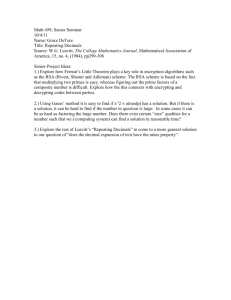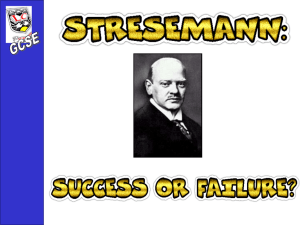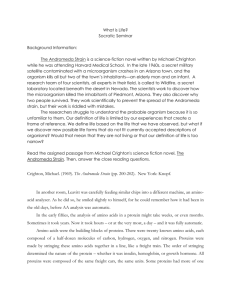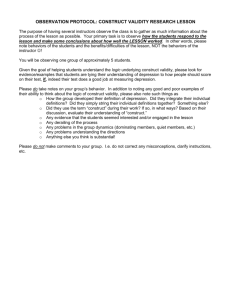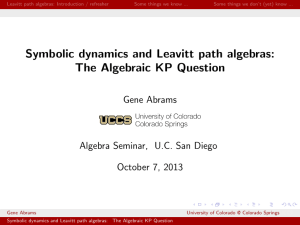Migrating-Locus - Futures Strategy Group
advertisement
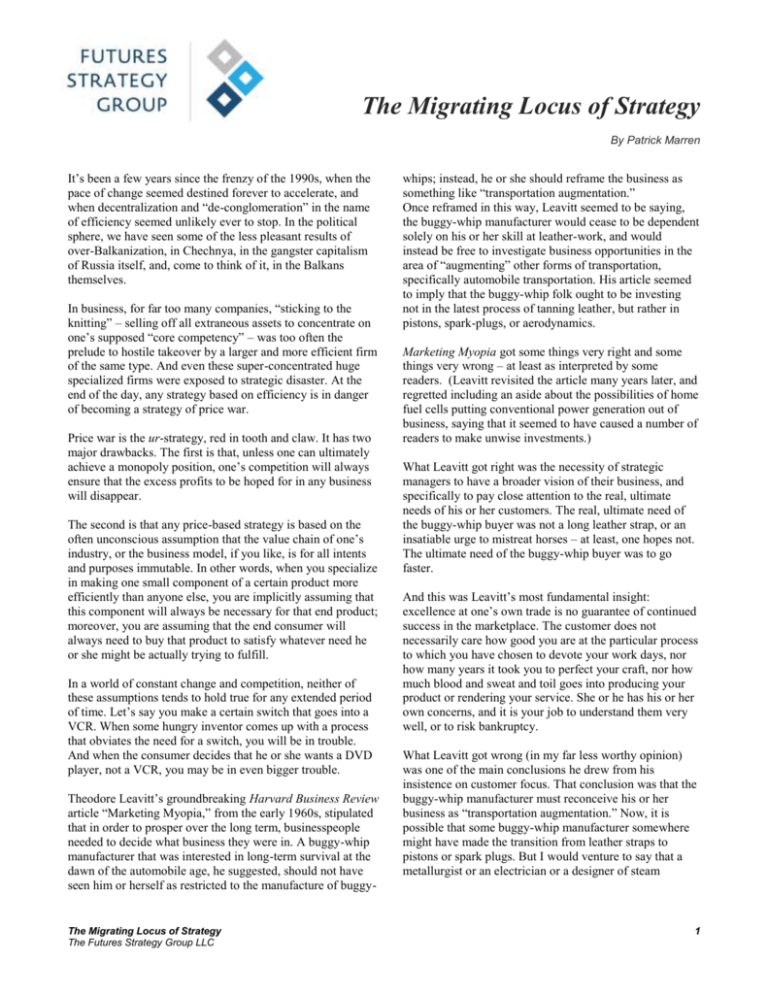
The Migrating Locus of Strategy By Patrick Marren It’s been a few years since the frenzy of the 1990s, when the pace of change seemed destined forever to accelerate, and when decentralization and “de-conglomeration” in the name of efficiency seemed unlikely ever to stop. In the political sphere, we have seen some of the less pleasant results of over-Balkanization, in Chechnya, in the gangster capitalism of Russia itself, and, come to think of it, in the Balkans themselves. In business, for far too many companies, “sticking to the knitting” – selling off all extraneous assets to concentrate on one’s supposed “core competency” – was too often the prelude to hostile takeover by a larger and more efficient firm of the same type. And even these super-concentrated huge specialized firms were exposed to strategic disaster. At the end of the day, any strategy based on efficiency is in danger of becoming a strategy of price war. Price war is the ur-strategy, red in tooth and claw. It has two major drawbacks. The first is that, unless one can ultimately achieve a monopoly position, one’s competition will always ensure that the excess profits to be hoped for in any business will disappear. The second is that any price-based strategy is based on the often unconscious assumption that the value chain of one’s industry, or the business model, if you like, is for all intents and purposes immutable. In other words, when you specialize in making one small component of a certain product more efficiently than anyone else, you are implicitly assuming that this component will always be necessary for that end product; moreover, you are assuming that the end consumer will always need to buy that product to satisfy whatever need he or she might be actually trying to fulfill. In a world of constant change and competition, neither of these assumptions tends to hold true for any extended period of time. Let’s say you make a certain switch that goes into a VCR. When some hungry inventor comes up with a process that obviates the need for a switch, you will be in trouble. And when the consumer decides that he or she wants a DVD player, not a VCR, you may be in even bigger trouble. Theodore Leavitt’s groundbreaking Harvard Business Review article “Marketing Myopia,” from the early 1960s, stipulated that in order to prosper over the long term, businesspeople needed to decide what business they were in. A buggy-whip manufacturer that was interested in long-term survival at the dawn of the automobile age, he suggested, should not have seen him or herself as restricted to the manufacture of buggy- The Migrating Locus of Strategy The Futures Strategy Group LLC whips; instead, he or she should reframe the business as something like “transportation augmentation.” Once reframed in this way, Leavitt seemed to be saying, the buggy-whip manufacturer would cease to be dependent solely on his or her skill at leather-work, and would instead be free to investigate business opportunities in the area of “augmenting” other forms of transportation, specifically automobile transportation. His article seemed to imply that the buggy-whip folk ought to be investing not in the latest process of tanning leather, but rather in pistons, spark-plugs, or aerodynamics. Marketing Myopia got some things very right and some things very wrong – at least as interpreted by some readers. (Leavitt revisited the article many years later, and regretted including an aside about the possibilities of home fuel cells putting conventional power generation out of business, saying that it seemed to have caused a number of readers to make unwise investments.) What Leavitt got right was the necessity of strategic managers to have a broader vision of their business, and specifically to pay close attention to the real, ultimate needs of his or her customers. The real, ultimate need of the buggy-whip buyer was not a long leather strap, or an insatiable urge to mistreat horses – at least, one hopes not. The ultimate need of the buggy-whip buyer was to go faster. And this was Leavitt’s most fundamental insight: excellence at one’s own trade is no guarantee of continued success in the marketplace. The customer does not necessarily care how good you are at the particular process to which you have chosen to devote your work days, nor how many years it took you to perfect your craft, nor how much blood and sweat and toil goes into producing your product or rendering your service. She or he has his or her own concerns, and it is your job to understand them very well, or to risk bankruptcy. What Leavitt got wrong (in my far less worthy opinion) was one of the main conclusions he drew from his insistence on customer focus. That conclusion was that the buggy-whip manufacturer must reconceive his or her business as “transportation augmentation.” Now, it is possible that some buggy-whip manufacturer somewhere might have made the transition from leather straps to pistons or spark plugs. But I would venture to say that a metallurgist or an electrician or a designer of steam 1 engines might have had a more than slight advantage over our poor tanner. The right thing for the buggy-whip manufacturer to do, in my opinion, would not be to shackle his or her fortunes to his current customer set, but rather to take stock of his or her assets and skill base, and to imagine people beyond his or her current customer base who might be in need of both current and entirely new products that he or she might be capable of providing. Instead of trying to make a better spark-plug or piston, maybe leather driving apparel or driving gloves or even automobile seats might be a better choice; still better, he or she could get completely beyond the transportation field in order to maximize his or her chances. So Leavitt was right to insist on customer focus and on a broader conception of one’s business; but in Marketing Myopia, I would venture to say, his insistence on the current customer base was strategically limiting. The important lesson to take from the article is that if one is interested in maximizing the economic prospects of one’s business, one should have as broad a conception of one’s business, and as perfect a knowledge of one’s customers’ ultimate needs, as possible; one should be anticipating changes that might make necessary radical changes in the products and processes by which one’s customers are satisfied; but one should also be constantly looking for new customers that might benefit from one’s expertise. Back to the late 1990s consolidation and shakeout. Consultants and businesspeople (aside from General Electric and Jack Welch, and perhaps Warren Buffett, who were seen as the exceptions that proved the rule) were death on conglomeration in the 1990s. Articles told managers that they had to identify a core competency and jettison all extraneous activities, while acquiring other similar businesses to build scale and/or market share. Conglomeration, after all, was senseless in an age in which investors could assemble their own virtual conglomerates by day-trading. In an age when competition was ruthless and efficiency was absolutely necessary, scale and specialization were demanded of the business enterprise. At the level of the industry, and even more at the level of the economy, however, something interesting seemed to be happening. Intelligent managers, urged on by both consultants and Wall Street, were systematically stripping their companies of all strategic flexibility. Every company seemed to think that they were going to be the winner in the consolidation wars: that, if they just played their cards right, XYZ Screw Corporation of Silver Lake, Ohio was ultimately going to take over General Motors. There were some cases of hitherto unknown firms taking over household names in this way. Of course, what mainly happened was a process of big fish swallowing smaller ones, then being swallowed by even bigger ones. Specialization and “sticking to the knitting” at The Migrating Locus of Strategy The Futures Strategy Group LLC the level of the enterprise turned out to be a formula for the disappearance of most enterprises, while at the level of the industry and economy, it was a mechanism for a vast increase in concentration. Industries long home to dozens of competitors found themselves in the course of a few years to have become oligopolies. From an economic efficiency standpoint, and from a consumer standpoint, this made some sense. But to managers whose summum bonum was strategic autonomy, the result was disaster. The vast majority of managers who set out to become bigger players in more narrowly-defined market niches ended up being bought out and losing all strategic autonomy (though they also often ended up with lucrative buyouts to assuage their injured pride and lower their golf handicaps). The tune was called by Wall Street and the consulting intelligentsia, and managers responded like lemmings, or, more charitably, iron filings in the presence of powerful magnetism. But are the winners really all that much better off than those they have swallowed? In some cases yes, in many others, no. Many studies have shown that the net economic effect of acquisition is negative on the acquiring firm; the common response of Wall Street to proposed acquisitions is to discount the acquiring firm’s stock and to push up the stock of the company being acquired. (The response of Wall Street to the recent acquisition of Sears by K-Mart – an increase in both companies’ stock prices – was notable precisely because of its violation of this near-universal norm.) The economy of today seems to be in a period of digestion, with growth and change both at lower levels than a few years ago. One might also expect some of the competency-focused, by-definition inflexible giants to be running into trouble by now, as innovation begins to ace the out of their formerly privileged spots on the value chain. One might also expect traditional conglomerates to be doing relatively better, compared to the competencyfocused organizations. But the data seems to be mixed, perhaps because of the still questionable economic climate. If it is true that the market has been demanding narrow focus on competency, and that such narrow focus increases the risk of strategic failure for the individual firm, what is the upshot for strategy? A market that forces individual firms into difficulty might still be providing a superior outcome overall for the economy. Hayek’s view of capitalism as “creative destruction” implies that a certain amount of destruction is necessary for a net positive societal outcome. If firms continually find themselves forced by Wall Street or their individual markets to make decisions that they do 2 not necessarily regard as strategically wise, then where does strategy reside in the economy? It is quite possible that the financial markets, due to increased technological sophistication and complexity, have taken onto themselves a lot of the decisions that used to be called “strategic management.” Adam Smith’s “invisible hand” may increasingly be arrogating to itself many choices that managers would formerly have made for themselves. At the level of the enterprise, many of these decisions, or to be more precise, demands by the market upon the management of the company, may appear illogical or even crazy. But if this theory is correct, at some higher level they may pass for sublime wisdom. An alternative possibility is that with strategy being overlooked right now, and everyone engaged in almost identical cost-focused number-crunching, there may be splendid returns to be gotten through investment in a little anticipatory strategic thinking. Either way, the strategic planners that remain, if they want to provide a real service, must not only inform their management of the entire sphere of possible strategic actions available to them; they must also inform them of the often far larger universe of outside conditions and contingencies that they cannot influence but may be forced to react to. Leavitt’s implied dictum of looking “from the outside in” is probably more urgent today than ever before. * A quick look at the current consulting market gives some interesting food for thought. More than ever, nuts-and-bolts numerical analysis rules, and strategy is almost nowhere to be seen. Top consulting firms themselves appear to be narrowly focused on providing cost savings to their clients after the consolidation of the late 1990s. “Strategic planning” is somewhat passé. Are companies obeying some higher law that pushes them toward lemming-like self-destruction for the greater good of the economy? The Migrating Locus of Strategy The Futures Strategy Group LLC * * This article originally appeared in the Journal of Business Strategy, Vol. 26, No. 2, April 2005 (pp. 4-6). It may be accessed at: http://www.emeraldinsight.com/Insight/viewContentItem.d o?contentType=Article&contentId=1465127. 3
